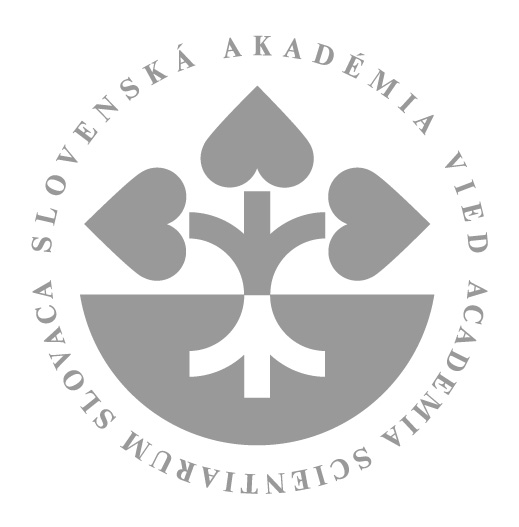- Interstellar particles in the Solar system’s interplanetary medium
- The origin and formation of the inner Oort cloud
- On the collisions between the main-belt asteroids and shower meteors
- Doubly and multiply eclipsing systems
- Solar activity cycles – empirical implications for the solar dynamo modelling
- Formation of young stars of T Tauri type and their planetary systems
The Astronomical Institute SAS organizes PhD study in astronomy and astrophysics.
| Application deadline: | May 15th 2022 |
| Address: | Astronomicky ustav SAV, v. v. i. Tatranska Lomnica, 059 60 Vysoke Tatry |
| Interviews: | during June of 2022 |
| PhD study (start): | September 1st 2022 |
Conditions for the interview:
1. Graduation of the University study at the Master level (the 2nd education degree). Applicants from the outside of EU are required to submit “Recognizing certificates on the 1st and 2nd education degree acquired at universities abroad” at the registration of his/her study (around the beginning of September). See: Recognizing certificates on study abroad
2. Filled in application with its attachments sent to the address of the Astronomical Institute SAS within the given deadline.
For the PhD program of Astronomy and Astrophysics, Astronomical Institute SAS advertises the following themes:
- Interstellar particles in the Solar system’s interplanetary medium
Adviser: RNDr. Mária Hajduková Jr., PhD. (Maria.Hajdukova@savba.sk)
Affiliation: Astronomical Institute of the Slovak Academy of Sciences, The Department of Interplanetary Matter, Bratislava
Syllabus
Focus of the research: The interaction of our Solar system with the interstellar medium, due to the motion of the Sun relative to the local interstellar cloud, should lead to the presence of interstellar particles, or, at least, interstellar dust grains. Viewed from within the Solar system, a flow of interstellar matter should be observed. Since identifying particles of interstellar origin is a challenge, the true abundance of interstellar particles in the Solar system has not yet been unambiguously determined.
Objectives: The aim of this work is to map the influx of the interstellar particles and follow their trajectories through the Solar system. These are influenced by their interaction with the interplanetary medium and controlled by a number of size-dependent forces. The emphasis of this work lies on large particles approaching the Earth’s orbit on hyperbolic orbits with respect to the Sun, which can be observed as meteors.
Computer simulations of interstellar particles’ trajectories will be compared with observational data from the avaliable meteor databases. The substantial question is the ratio of the interstellar particles to those belonging to the interplanetary medium, which we should register in a particular region. This depends on the distance from both the Sun and the ecliptic. Therefore, the results of Earth-based and space-born observations will be synthesized to achieve a broader view.
Requirements:
programming, the English language
Research field:
The dynamical evolution of the small bodies of the Solar system - The origin and formation of the inner Oort cloud
Supervisor: Mgr. Marián Jakubík, PhD. (mjakubik@astro.sk)
Affiliation: Astronomical Institute of the Slovak Academy of Sciences, Tatranská Lomnica, 059 60 Vysoké Tatry
Syllabus
Focus of the research: The origin and formation of the Oort cloud, spherically symmetric cloud of comets orbiting the Sun in orbits with semi-major axis from 2000AU to 200000AU, are the focus of our research. The Oort cloud can be divided into 2 parts – inner and outer Oort cloud. There are models, which describe scenarios of the origin and formation of Oort cloud resulting from very recent observations. So far, the most suitable are models from time-period when the Sun was located in its birth star cluster. These models of the formation of Oort cloud (both parts) can realistically describe many details, which we can obtain from observations of comets and trans-neptunian objects.
Objectives: The main aim of this work is detailed description of the origin and formation of inner Oort cloud with main emphasis on models describing the formation of the Oort cloud in its birth star cluster. In more detail, we will solve open questions of this process using numerical simulations with respect of recent observations. Among answers on various open questions, we will find the solution of particular problem related to high number of objects (in the inner Oort cloud) revolving around Sun on retrograde orbits resulting from previous numerical simulations. However, this fact does not result from the analysis of recent available observations of inner Oort cloud objects.
Requirements:
programming skills (python, fortran), English language
Research field:
The dynamical evolution of the small bodies of the Solar system - On the collisions between the main-belt asteroids and shower meteors
Supervisor: RNDr. Luboš Neslušan, CSc. (ne@astro.sk)
Affiliation: Astronomical Institute of the Slovak Academy of Sciences, Tatranská Lomnica, 059 60 Vysoké Tatry
Syllabus
Focus of the research: In the recent decades, a cometary activity of some asteroids in the main belt was observed. This phenomenon rose a question about a mechanism triggering such an activity. One of possible mechanisms can be a collision with a meteoroid. The sporadic meteoroids are dispersed in the interplanetary space and probability of collision of an asteroid with a sporadic meteoroid is much smaller than the probability of collision with a meteoroid, which is a member of a stream and moves around the Sun in a spatial corridor with a relatively large number density of meteoroid objects.
Objectives: The goal of the work is a determination of frequency of asteroid passages through the corridors of cometary meteoroid streams and also known streams, the parent body of which is not known. Because of a huge number of known asteroids, the object of the study will be only the large asteroids (with the absolute magnitude larger than a chosen limit) in the main belt. For few streams with a relatively well-known size distribution of the members, the frequency of collisions between some asteroids and the stream members of the specific size-intervals should be estimated.
Requirements:
— completed university study of astronomy, achieved master degree, or in a similar field, if in similar field, the candidate should give an evidence of his or her experience in meteor astronomy (at least one published paper in this field is regarded as the evidence)
— knowledge of computer programing, generally, and of programing language Fortran or C
— sending (to supervisor) of a short document (1 to 2 pages) describing the research interest of the applicant in his/her career in a near future (about 10 years); not only in concern of the PhD study
— good speaking and writing in English
— a knowledge of creation of active web pages, i.e. PHP language, as well as of MySQL database are welcome
Research field:
The dynamical evolution of the small bodies of the Solar system - Doubly and multiply eclipsing systems
Supervisor: Dr. Theodor Pribulla (pribulla@ta3.sk)
Affiliation: Astronomical Institute of the Slovak Academy of Sciences, Stellar Department, Tatranská Lomnica
Syllabus
Focus of the research: Systematic satellite observations aiming at the detection and study of exoplanets (CoRoT, KEPLER, TESS) lead to discovery of triple and quadruple stellar systems showing eclipses both in the inner and outer orbits (multiply eclipsing) or both inner orbits (doubly eclipsing). Because the geometry of the eclipses depends on the size and the mutual inclination of the orbits, it is possible to determine masses of the components without a need for spectroscopic observations. In the case that high-dispersion spectroscopy is available, it is possible to improve the parameters and to derive more parameters. Spectroscopy taken during the eclipses enables us to determine projected spin-axis orbital plane misalignment by using so-called Rossiter-McLaughlin effect. The misalignment strongly affects the apsidal motion rate in systems with eccentric orbits. It also provides us an information on the evolutionary history of the particular multiple system. If the outer-to-inner orbital period ratio is small, it is possible to observe anomalous apsidal motion and sometimes also perturbations of the inner orbits. Modeling of such systems requires inclusion of various effects (for example the finite speed of the light, reflection effect, ellipticity of the components, gravitational darkening). Modeling of high-precision satellite photometry is exacting and requires realistic models and accurate synthesis of observables. Systematic differences of the model and observed light curves point to other yet unknown effects or model inaccuracies (e.g., gravity darkening and reflection effect).Objectives:
Detection and modeling doubly and multiply eclipsing systems. Determination of the orbital and absolute parameters of the components. Including fine light-curve effects in the modeling of eclipses.Requirements:
good knowledge of English, knowledge of programming, ability to work independently with literature
Research field:
Classical binaries and multiple stellar systems - Solar activity cycles – empirical implications for the solar dynamo modelling
Adviser: RNDr. Ján Rybák, CSc. (choc@astro.sk)
Affiliation: Astronomical Institute of the Slovak Academy of Sciences, Tatranská Lomnica, 059 60 Vysoké Tatry
Syllabus
An analysis of the long-term observations of the solar activity –
sunspots, magnetic fields as well as measurements of prominences and
green corona – for determination of behaviour and importance of
manifestations of different activity separately on individual
hemispheres of the Sun with searching for empirical implications for
modelling of the solar activity by numerical methods describing the
solar dynamo. An expected output of the research is determination
of the temporal evolution of the time-latitude asymmetry of the solar
activity for time period of several solar activity cycles and an
analysis of its importance for different periods together with
searching for probable periodicities of the activity.
Requirements:
English language, programming skills, physical background
Research field:
Research of physical properties and processes in the atmosphere of the Sun - Formation of young stars of T Tauri type and their planetary systems
Adviser: Mgr. Martin Vaňko, PhD. (vanko@astro.sk)
Affiliation: Astronomical Institute of the Slovak Academy of Sciences, Tatranská Lomnica, 059 60 Vysoké Tatry
Syllabus
Context: T Tauri are young (up to 100 Myr), low mass (less than 3 solar masses) highly variable late-type (later than F-type) stars with peculiar emission line spectra, associated with nearby molecular clouds the Star-Forming Regions (SFR, e.g. Rho Ophiuchi cloud complex, Orion Nebula, Taurus-Auriga, Cepheus-Cassiopeia). Their spectra also show high abundance of lithium with respect to that of the Sun and other main-sequence stars. T Tau stars are divided into two subgroups:(i) classical” TTS always embedded in a circumstellar envelope (CTTS), and (ii) the “weak-line” TTS with no longer indicated circumstellar envelope (WTTS). It has been found that TTS, in particular of the WTTS type, can be associated with strong X-ray emission and high rotation velocities (tens of km/s). High-resolution near-IR surveys indicate that a majority of the young stars are binaries or multiple systems with a typical separation of 0.3 – 0.5 arcsec. A study of TTS, in particular within binaries and multiple systems, allows us to better understand their origin and evolution until the stage when they will start to shine in the optical and become normal stars, as well as possible formation of their planetary systems.
Aims: Follow-up observations for candidate T Tauri stars and modelling of binary components containing a few Myr young stars to determine their physical parameters, rotational periods, character and nature of the observed photometric variability. Acquiring of multicolour photometry (including much desired U-band) of selected T Tauri stars.
Methods: Photometric monitoring of selected objects in the Cepheus-Cassiopeia region using telescopes of AI SAS. Spectroscopic observations will be used to obtain radial velocity curves and to detect the Li 670.8 nm line, as an indicator of the age. The selected targets are suitable for observations with échelle spectrograph MISICOS (R=35000) mounted at 1.3-m Nasmyth-Cassegrain telescope at Skalnaté Pleso Observatory.
Requirements:
English language, programming skills, physical basis
Research area:
Classical binaries and multiple stellar systems
For further information, please contact supervisors via email…
In Tatranska Lomnica, February 16th, 2022
Mgr. Peter Gömöry, PhD.
Director of the AISAS
Requirements
Programme: ASTRONOMY AND ASTROPHYSICS
-
- Interview (PDF)
- Dissertation exam: ASTRONOMY (PDF)
 SAS
SAS

